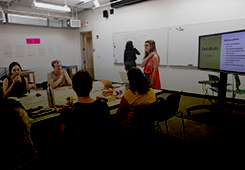The Benefits of Mindfulness in the Classroom (especially during stressful times)

By Deborah Donahue-Keegan, Lecturer, Department of Education
The end of a semester is always stressful. As faculty, many of us feel a mix of relief and some grief as we wind down our courses, bring closure to classes with students we’ve come to know, and anticipate an intense round of end-of-semester assessments—final exams and/or papers, and final grades… The end of the Fall 2016 semester is extraordinarily stressful because of the intensely polarized, emotionally-laden post-election landscape. In this post, I offer ideas from my own experience for why and how contemplative practices can help.
How I bring mindfulness into my teaching
Since participating in an intensive week-long institute offered by the Cultivating Awareness and Resiliency in Education (CARE) program during the summer of 2011, I have brought contemplative practices, specifically mindfulness, to the courses I teach. What is mindfulness? Here’s a succinct, commonly accepted definition: Paying attention to the here and now, with non-judgment and acceptance. What is stated on the CARE website encapsulates my reason for bringing mindfulness into my courses: “Cutting-edge neuroscience confirms that practicing mindfulness facilitates awareness and self-regulation and develops the capacity for a calm, focused mind… for optimal learning” (CREATE) It’s about cultivating an optimal environment for deep learning and intellectual rigor.
I incorporate mindfulness into my teaching two main ways: 1) through my own intra-personal practice, and 2) through an optional “time for pause” (T4P) exercise (with approximately 3-5 minutes for “present moment awareness” through intentional breathing exercises) with students at the beginning of each class session. As far as my own practice, what has made a very positive difference is my now-habit of finding 5-10 minutes of uninterrupted time alone within an hour before a class begins. During this personal “time for pause” I focus on deep breathing in a “triple five times five” way, by deeply breathing in to the count (silent) of five, then holding for five, and then slowly exhaling while counting down from five; I repeat this cycle four more times. I then take about a minute to set my intention for the upcoming class session; different from curriculum goals (which I hold at the same time) setting an intention is about purposeful ways of being, a quality of presence. Before turning to what “time for pause” with students during class looks like, I’ll explain how I invite students to consider the possible benefits of mindfulness for themselves, their relationships, and their work.
A brief look at the science of mindfulness:
At the beginning of each course, I provide students with a brief overview of the neuroscience research behind and neurobiological benefits of mindfulness practice, the exercise of intentionally paying full attention to the present moment, non-judgmentally. I present research that shows how consistently integrating this practice in academic settings is in service of deepening conceptual understanding, and heightening emotional intelligence. We look at the role of emotion oft ignored in higher education classrooms. As Marc Brackett asserts in his June 2016 New York Times essay, “today’s students may be emotionally unprepared [to] learn and thrive [and contribute] to the success of the broader society and economy.” As the Director of the Yale Center for Emotional Intelligence, Brackett’s research focuses on how “emotions drive learning, decision-making, creativity, relationships and health,” and why “mastering the skills of emotional intelligence paves the way for greater well-being, better relationships and overall.” His work aligns with robust neuroscience research that demonstrates how emotion and cognition are interrelated dimensions of human social functioning (Immordino-Yang & Damasio, 2008; Cozolino, 2013; Hardiman, 2012).
Consistent practice facilitates the development of emotional stamina, when an individual develops a balanced, calm autonomic nervous system as a baseline state, to manage fight or flight responses (Seppala, 2016; Yuan & Silberstein, 2016). As stated above, a calm, focused mind is also more receptive to deeper conceptual learning and understanding. When we develop emotional stamina, we are better able to access and activate social-emotional skills, as well as compassion and empathy, during highly stressful personal and/or professional situations. Mindful breathing practices can promote the development of social-emotional stamina and well-being through facilitating present-moment awareness and non-judgmental acceptance of one’s feelings, thoughts and bodily sensations within the surround of one’s environment (Greater Good Science Center, n.d.; Seppala, 2016). Concomitantly, these practices can lead to a simultaneous decrease in bodily stress hormones (e.g. cortisol) and increase levels of dopamine and serotonin—neurotransmitters that promote emotion regulation and proactive relationship behaviors—and oxytocin, the hormone in service of positive relational connecting (Greater Good Science Center, n.d.) improved intercultural interactions (Spencer-Oatey, 2013) and optimal learning (Broderick, 2013; Jennings et al., 2013).
Observed Impact: Student Reactions to Mindfulness Practice
In their written feedback on “exit cards” at the end of each class throughout the semester, students often comment on how “time for pause” practices help them to be more fully present and engaged during classes. For example, here are two statements recently respectively written by a couple of ED-164 students:
“I’ve really enjoyed our Time for Pauses and have even found myself scheduling in little moments before my other classes to practice it. It’s so helpful, especially for a three-hour evening class, to have that moment to center yourself, focus and remember to breathe.”
“Mindfulness work we’ve done in class has contributed to a calmer academic experience, where I feel I can leave the rest of the day outside and focus. It has also creeped its way into my daily life as well–often when I get nervous I now find myself utilizing some of the methods from the first two minutes of Ed-164 each week to calm down.”
I have noticed that students in my courses seem to engage in difficult dialogues, related to controversial close-to-home issues we address in the course (education inequity, racial injustices, microaggressions, marginalization, oppression, etc.), in more calm and constructive ways than before I incorporated mindfulness in my courses. Students seem to be much less reactive, and more receptive to intra-personal reflection, inter-personal dialogue, and systemic inquiry. Through weaving in quick “time for pause” moments throughout class sessions involving difficult dialogues regarding complex issues, I have noticed that, overall, students seem more willing to engage in dissonance. Many students report (through journal entries, conversations during and after respective courses, and course evaluation responses) that this contemplative approach to learning helps them be more receptive to considering different perspectives, and better able to actively listen to others with empathy and compassion.
My Personal Journey
Mindfulness means attending to one’s internal assumptions, cognitions, and emotions, and simultaneously attuning to the other’s assumptions, cognitions, and emotions (Ting-Toomey 1999).
For me, becoming a contemplative educator is an ongoing process that involves continuous engagement in mindfulness practices, in furtherance of cultivating my own self-reflection and self-awareness, and engaging in (and modeling) culturally responsive, socially-emotionally attuned teaching approaches in my education courses, with my students as co-learners. It takes constant practice; sometimes I fall short. It is an ongoing process. Overall, though, I know that bringing mindfulness into my teaching has helped me to do the following in better ways:
- listen more deeply and non-judgmentally during classes, and when advising students during one-on-one meetings;
- examine my own assumptions and possible misinterpretation;
- respond rather than reacting to emotional distress that inevitably arises (for students and/or me) during difficult dialogues, when addressing controversial topics in class;
- develop stronger relational trust with students;
- facilitate deep learning.
Higher Ed resources
From Vanderbilt University:
https://cft.vanderbilt.edu/guides-sub-pages/contemplative-pedagogy/
The Association for Contemplative Mind in Higher Education(ACMHE):
http://www.contemplativemind.org/practices/recordings
Contemplative Sciences Center, University of Virginia
http://www.uvacontemplation.org/content/mindfulness-center
Benefits of Breathing: The Scientific Benefits of Breathing (infographic)
By Emma Seppälä
https://emmaseppala.com/benefits-breathing-scientific-benefits-breathing-infographic/
References:
Brackett, M. (2016). Today’s Students May Be Emotionally Unprepared. New York Times(2016, June 22). Retrieved from https://www.nytimes.com/2016/06/23/education/todays-students-may-be-emotionally-unprepared.html
Broderick, P. (2013). Learning to Breathe: A Mindfulness Curriculum for Adolescents to Cultivate Emotion Regulation, Attention, and Performance. Myla Kabat-Zinn (Foreword), Jon Kabat Zinn (Foreword). Oakland, CA: New Harbinger Publications, Inc.
Cozolino, L. J. (2013). The social neuroscience of education: Optimizing attachment and learning in the classroom. New York, NY: W. W. Norton & Company.
Cultivating Awareness & Resilience in Education (CARE) http://createforeducation.org
Greater Good Science Center (University of California, Berkeley) https://greatergood.berkeley.edu/
Hardiman, M. M. (2012). The brain-targeted teaching model for 21st-century schools. Thousand Oaks, CA: Corwin.
Immordino-Yang, M. H., & Damasio, A. (2008). We Feel, Therefore We Learn: The Relevance of Affective and Social Neuroscience to Education. Mind, Brain, and Education, 1(1), 3-10. doi:10.1111/j.1751-228x.2007.00004.x
Jennings, P. A., Frank, J. L., Snowberg, K. E., Coccia, M. A., & Greenberg, M. T. (2013). Improving classroom learning environments by Cultivating Awareness and Resilience in Education (CARE): Results of a randomized controlled trial. School Psychology Quarterly, 28, 374-390. doi: 10.1037/spq0000035.
Seppala, E. (2016). Breathing: the little known secret to peace of mind. Psychology Today. Retrieved from https://emmaseppala.com/breathing-the-little-known-secret-to-peace-of-mind/
Spencer-Oatey, H. (2013) Mindfulness for Intercultural Interaction. A compilation of quotations. GlobalPAD Core Concepts. Available at GlobalPAD Open House.
Ting-Toomey, S. (1999). Communicating across Cultures. New York: The Guilford Press.
Yuan, H. and Silberstein, S. D. (2016), Vagus Nerve and Vagus Nerve Stimulation, a Comprehensive Review: Part I. Headache, 56: 71–78. doi:10.1111/head.12647 Retrieved from https://www.ncbi.nlm.nih.gov/pubmed/26364692



